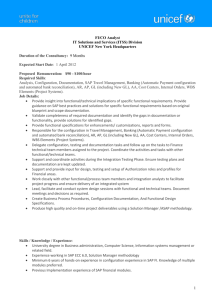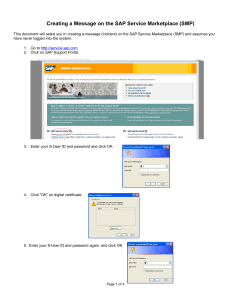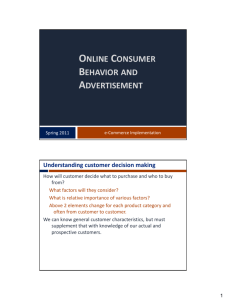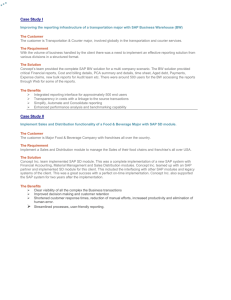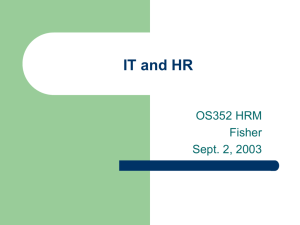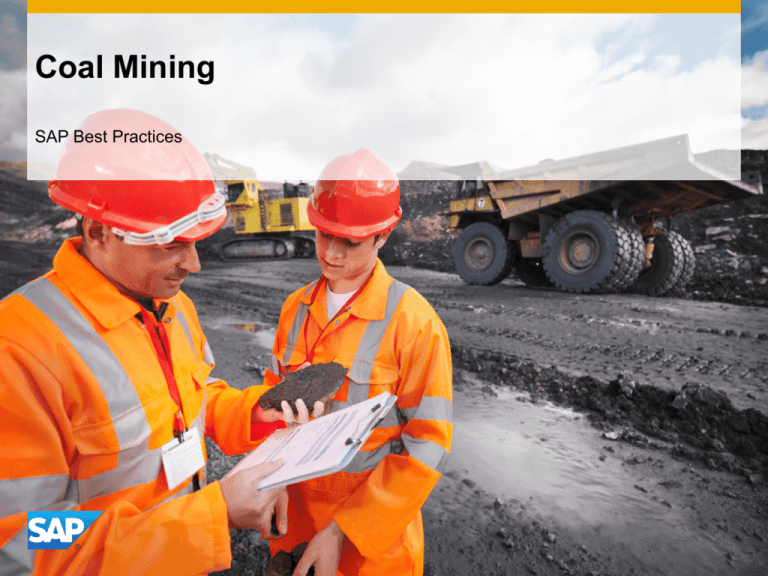
Coal Mining
SAP Best Practices
Purpose, Benefits
Purpose
• This scenario describes the complete process from mine to stockpile as an example. It
could be also used to describe the process from a quarry to stockpile in the building
material industries. The scenario includes crushing of the rock and moving to a
stockpile.
Benefits
• PI (Process Instruction) sheets are used to manually record production achievement.
The PI sheet provides a user friendly interface that allows production operators to
enter data in a customized manner.
• A production batch is created for the process order, which allows quality characteristics
(assays) to be recorded in the system. This batch represents the quantity and quality
of the crushed coal produced for the time period specified by the process order. The
batch characteristics for the stockpile batch are then adjusted based on a weighted
average calculation of contributing batches of coal.
• PM measurement point is integrated, truck related KPI is stored in the created
measurement documents.
© 2012 SAP AG. All rights reserved.
‹#›
Required SAP Applications and Company Roles
Required SAP Applications
• SAP enhancement package 6 for SAP ERP 6.0
Company Roles
• Production Planner
• Shop Floor Specialist
• Equipment Operation Manager
• Warehouse Manager
Key Process Steps
• Create a Process Order for Hauling (crushing) Coal
• Control Recipe Monitor
• Maintain Production Data Using PI Sheet
• Process the Entered Production Data
© 2012 SAP AG. All rights reserved.
‹#›
Detailed Process Description
Loading and Hauling in the Mine
•In
the first step of this scenario coal is extracted and hauled to the crusher. Actual
operating details (hours, tonnes, fuel used) for each haul truck are entered into the
PI sheet. These are then posted in background to update the logistics, financial, and
plant maintenance information in SAP ERP. ROM Coal produced will be used as
feed-stock for the crushing process. Truck details are passed to Plant Maintenance
and can be used to schedule and manage future maintenance activities.
© 2012 SAP AG. All rights reserved.
‹#›
Detailed Process Description
Crushing Coal
•A second
process order represents the crushing process. ROM coal feed-stock is
passed through a crusher to create crushed coal. Again a PI sheet is used to record
the production data. For the crushing operation a production batch is created for
the process order. This allows quality characteristics (assays) to be recorded in the
system. This batch represents the quantity and quality of the crushed coal produced
for the time period specified by the process order.
•In
the PI sheet for crushing the operator selects the stockpile (or stockpiles) onto
which that day’s production is transferred. A batch to batch movement is carried out
to move the production batch quantity from the process order onto the stockpile
batch. The batch characteristics for the stockpile batch are then adjusted based on
a weighted average calculation of contributing batches of coal.
© 2012 SAP AG. All rights reserved.
‹#›
Process Flow Diagram
Event
Production
Planner
4.1.1
Create Process
Order for
Hauling Coal
Production
Worker
4.1.2
Create
Production Data
Entry Sheet
4.1.3
Display
Measurement
Document
Quality Manager
Loading
and Hauling
in the Mine
Generic EAM
Functions
Coal Mining (Mining Operations)
© 2012 SAP AG. All rights reserved.
4.1.6
Displaying the
Process Order
for Hauling Coal
4.1.4
Entering
Production Data
using PI Sheet
4.1.5
Processing
Entered
Production Data
4.1.7
Displaying
Process Order
Confirmation
(Optional)
4.1.8
Displaying
Measurement
Document
4.1.9
Changing Batch
(Optional)
Contd. To
Page 2
‹#›
Process Flow Diagram
Event
Production
Planner
4.2.1
Create Process
Order for
Crushing Coal
4.2.2
Creating
Production Data
Entry Sheet
Quality Manager
Crushing
Coal
Production
Worker
Coal Mining (Crushing Operations)
© 2012 SAP AG. All rights reserved.
Contd.
From
Page 1
4.2.5
Displaying
Process Order
for Crushing
Coal
4.2.3
Entering
Production Data
for Crushing
Coal
4.2.4
Processing
Entered
Production Data
4.2.6
Displaying
Process Order
Confirmation
(Optional)
4.2.7
Displaying
Material
Document for
Material
4.2.8
Changing Batch
(Optional)
‹#›
Legend
<Function>
Symbol
Description
Usage Comments
Band: Identifies a user role, such as Accounts
Payable Clerk or Sales Representative. This band
can also identify an organization unit or group,
rather than a specific role.
Role band contains
tasks common to that
role.
Symbol
Diagram
Connection
The other process flow symbols in this table go
into these rows. You have as many rows as
required to cover all of the roles in the scenario.
External
to SAP
External Events: Contains events that start or end
the scenario, or influence the course of events in
the scenario.
Business
Activity / Event
SubProcess
Reference
Process
Decision
Flow line (solid): Line indicates the normal sequence
of steps and direction of flow in the scenario.
Flow line (dashed): Line indicates flow to
infrequently-used or conditional tasks in a
scenario. Line can also lead to documents involved
in the process flow.
Connects two tasks in
a scenario process or
a non-step event
Business Activity / Event: Identifies an action that
either leads into or out of the scenario, or an
outside Process that happens during the scenario
Does not correspond
to a task step in the
document
Unit Process: Identifies a task that is covered in a
step-by-step manner in the scenario
Corresponds to a task
step in the document
To next / From last Diagram: Leads
to the next / previous page of the
Diagram
Flow chart continues on the next /
previous page
Hardcopy / Document: Identifies a
printed document, report, or form
Does not correspond to a task
step in a document; instead, it is
used to reflect a document
generated by a task step; this
shape does not have any outgoing
flow lines
Financial Actuals: Indicates a
financial posting document
Does not correspond to a task
step in a document; instead, it is
used to reflect a document
generated by a task step; this
shape does not have any outgoing
flow lines
Budget Planning: Indicates a
budget planning document
Does not correspond to a task
step in a document; instead, it is
used to reflect a document
generated by a task step; this
shape does not have any outgoing
flow lines
Manual Process: Covers a task
that is manually done
Does not generally correspond to
a task step in a document;
instead, it is used to reflect a task
that is manually performed, such
as unloading a truck in the
warehouse, which affects the
process flow.
Existing Version / Data: This block
covers data that feeds in from an
external process
Does not generally correspond to
a task step in a document;
instead, this shape reflects data
coming from an external source;
this step does not have any
incoming flow lines
System Pass / Fail Decision: This
block covers an automatic
decision made by the software
Does not generally correspond to
a task step in the document;
instead it is used to reflect an
automatic decision by the system
that is made after a step has been
executed.
Financial
Actuals
Process Reference: If the scenario references
another scenario in total, put the scenario number
and name here.
Corresponds to a task
step in the document
Sub-Process Reference: If the scenario references
another scenario in part, put the scenario number,
name, and the step numbers from that scenario
here
Corresponds to a task
step in the document
Process Decision: Identifies a decision / branching
point, signifying a choice to be made by the end
user. Lines represent different choices emerging
from different parts of the diamond.
Does not usually
correspond to a task
step in the document;
Reflects a choice to
be made after step
execution
© 2012 SAP AG. All rights reserved.
Usage Comments
Hardcopy /
Document
Budget
Planning
Unit Process
Process
Reference
Description
Manual
Process
Existing
Version /
Data
System
Pass/Fail
Decision
‹#›
© 2012 SAP AG. All rights reserved
No part of this publication may be reproduced or transmitted in any form or for any purpose
without the express permission of SAP AG. The information contained herein may be
changed without prior notice.
Some software products marketed by SAP AG and its distributors contain proprietary
software components of other software vendors.
Microsoft, Windows, Excel, Outlook, PowerPoint, Silverlight, and Visual Studio are
registered trademarks of Microsoft Corporation.
IBM, DB2, DB2 Universal Database, System i, System i5, System p, System p5, System x,
System z, System z10, z10, z/VM, z/OS, OS/390, zEnterprise, PowerVM, Power
Architecture, Power Systems, POWER7, POWER6+, POWER6, POWER, PowerHA,
pureScale, PowerPC, BladeCenter, System Storage, Storwize, XIV, GPFS, HACMP,
RETAIN, DB2 Connect, RACF, Redbooks, OS/2, AIX, Intelligent Miner, WebSphere, Tivoli,
Informix, and Smarter Planet are trademarks or registered trademarks of IBM Corporation.
Linux is the registered trademark of Linus Torvalds in the United States and other countries.
Adobe, the Adobe logo, Acrobat, PostScript, and Reader are trademarks or registered
trademarks of Adobe Systems Incorporated in the United States and other countries.
Oracle and Java are registered trademarks of Oracle and its affiliates.
UNIX, X/Open, OSF/1, and Motif are registered trademarks of the Open Group.
Citrix, ICA, Program Neighborhood, MetaFrame, WinFrame, VideoFrame, and MultiWin are
trademarks or registered trademarks of Citrix Systems Inc.
HTML, XML, XHTML, and W3C are trademarks or registered trademarks of W3C®, World
Wide Web Consortium, Massachusetts Institute of Technology.
Apple, App Store, iBooks, iPad, iPhone, iPhoto, iPod, iTunes, Multi-Touch, Objective-C,
Retina, Safari, Siri, and Xcode are trademarks or registered trademarks of Apple Inc.
IOS is a registered trademark of Cisco Systems Inc.
INTERMEC is a registered trademark of Intermec Technologies Corporation.
Wi-Fi is a registered trademark of Wi-Fi Alliance.
Bluetooth is a registered trademark of Bluetooth SIG Inc.
Motorola is a registered trademark of Motorola Trademark Holdings LLC.
Computop is a registered trademark of Computop Wirtschaftsinformatik GmbH.
SAP, R/3, SAP NetWeaver, Duet, PartnerEdge, ByDesign, SAP BusinessObjects Explorer,
StreamWork, SAP HANA, and other SAP products and services mentioned herein as well
as their respective logos are trademarks or registered trademarks of SAP AG in Germany
and other countries.
Business Objects and the Business Objects logo, BusinessObjects, Crystal Reports, Crystal
Decisions, Web Intelligence, Xcelsius, and other Business Objects products and services
mentioned herein as well as their respective logos are trademarks or registered trademarks
of Business Objects Software Ltd. Business Objects is an
SAP company.
Sybase and Adaptive Server, iAnywhere, Sybase 365, SQL Anywhere, and other Sybase
products and services mentioned herein as well as their respective logos are trademarks or
registered trademarks of Sybase Inc. Sybase is an SAP company.
Crossgate, m@gic EDDY, B2B 360°, and B2B 360° Services are registered trademarks
of Crossgate AG in Germany and other countries. Crossgate is an SAP company.
All other product and service names mentioned are the trademarks of their respective
companies. Data contained in this document serves informational purposes only. National
product specifications may vary.
The information in this document is proprietary to SAP. No part of this document may be
reproduced, copied, or transmitted in any form or for any purpose without the express prior
written permission of SAP AG.
RIM, BlackBerry, BBM, BlackBerry Curve, BlackBerry Bold, BlackBerry Pearl, BlackBerry
Torch, BlackBerry Storm, BlackBerry Storm2, BlackBerry PlayBook, and BlackBerry App
World are trademarks or registered trademarks of Research in Motion Limited.
Google App Engine, Google Apps, Google Checkout, Google Data API, Google Maps,
Google Mobile Ads, Google Mobile Updater, Google Mobile, Google Store, Google Sync,
Google Updater, Google Voice, Google Mail, Gmail, YouTube, Dalvik and Android are
trademarks or registered trademarks of Google Inc.
© 2012 SAP AG. All rights reserved.
‹#›



